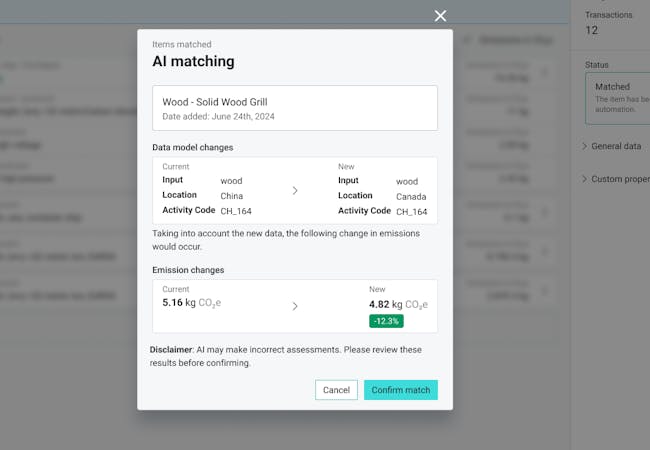When AI Knows Your BOM Better Than You Do
Every bill of materials and purchase order contains the detail needed to understand a product’s true carbon footprint. Carbmee’s AI automatically matches emission factors at SKU or transactional level from trusted databases, so calculations reflect real-world operations rather than generic estimates. The result is supplier-specific, verifiable Product Carbon Footprints that can scale across an entire portfolio.
How to get started: Begin by mapping your ERP material codes to a master list of products and components — even before gathering full emissions data. This will accelerate automated matching later.
Goodbye Guesswork, Hello Granularity
Inconsistent formats, missing values, and messy supplier data are common barriers to accurate Scope 3 accounting. Carbmee’s AI cleans, harmonizes, and enriches both primary and secondary data — detecting anomalies, standardizing naming conventions, and predicting missing values. This delivers a single source of truth that’s accurate enough for investor-grade reporting and agile enough for ongoing operational use.
How to get started: Audit your current carbon-related datasets for inconsistencies and gaps. Knowing where the data is messy will help the AI clean and enrich it faster.
An AI Dream Team for Decarbonization
Behind the scenes, Carbmee’s multi-agent AI works like a specialist team. One agent models LCAs and supply chain impacts, another identifies emissions hotspots, another ranks potential interventions by cost and feasibility, and another simulates regulatory exposure. Together, they produce reduction roadmaps that are grounded in operational data and tied to financial outcomes.
How to get started: Identify two or three key categories in your supply chain where you suspect the highest emissions intensity — these become your first modeling targets.
Turning Messy Data Into a Golden Record
Most enterprises juggle multiple ERP systems, supplier spreadsheets, and customs records. Carbmee unifies all of it into one auditable dataset, tagged for traceability. This foundation supports everything from supplier scoring and category-level benchmarking to automated compliance workflows — making it far easier for procurement, sustainability, and finance teams to work in sync.
How to get started: Consolidate your various data exports into one secure location so the AI can process them as a single dataset.
Not Just Reduction — Reduction With Receipts
Decarbonization strategies gain traction when they’re backed by a solid business case. Carbmee’s AI automatically generates Marginal Abatement Cost Curves, showing the CO₂ impact and cost per ton for every potential measure — from material substitutions to renewable energy sourcing. This ensures sustainability actions also make P&L sense.
How to get started: List your top five planned sustainability actions and note the expected costs. Having this baseline makes it easier to compare them against AI-generated scenarios.
Compliance Without the Heartburn
With CBAM, CSRD, and EUDR all reshaping regulatory landscapes, compliance is no longer just about ticking boxes — it’s about protecting margins. Carbmee models current and future exposure, automates reporting down to the required XML formats, and embeds compliance data directly into ongoing decision-making, so mitigation strategies are ready before the deadlines arrive.
How to get started: Create a simple timeline of upcoming reporting deadlines and regulatory milestones for your industry — this helps prioritise where compliance automation can have the fastest impact.
Ask Like a Human, Get Insights Like a Pro
Carbmee’s conversational AI lets anyone — not just carbon accounting experts — query the platform in plain language: “Show me our top Scope 3.1 categories” returns ranked lists, visual hotspot maps, and even suggested reduction pathways. In Studio, those insights can be turned into polished dashboards and reports in minutes for executives, suppliers, or auditors.
How to get started: Draft three to five “plain language” questions you’d like answered about your emissions data — these will form the basis for your first AI queries.
From Data to Decarbonization: Book Your Carbmee AI Demo Today
The fastest way to cut through sustainability complexity is to start — and the right AI can make that first step both simple and impactful. With Carbmee, you don’t need perfect data or months of manual work to see results. You need a clear starting point, a unified dataset, and a platform that turns information into measurable action. Book a demo today and see how quickly you can move from intention to implementation — and from reporting to real reduction — in weeks, not years.
![[object Object]](https://images.prismic.io/carbmee/aJYKIaTt2nPbaExK_AIBlogpost.png?auto=format,compress)






